About me

Hello!, welcome to my personal
webpage. I am Miguel Vioque and since January 2024 I am working as an ESO Fellow at the European Southern Observatory in Munich, Germany.
Born in Sevilla (Spain), I did my bachelor studies in Physics at the Universidad Complutense de Madrid (Spain) and at the University of Calgary (Canada). I obtained my master in Astrophysics and Cosmology at the Universidad Autónoma de Madrid (Spain). In October 2020, I received my PhD from the University of Leeds (UK) with a thesis titled "A census of Herbig Ae/Be stars. New candidates and analysis from a Gaia perspective" in which I studied and characterized the intermediate- to high-mass star formation regime using data from the Gaia mission, spectroscopy, and machine learning techniques. During my PhD, I had the privilege of doing an 18 month secondment at the European Space Astronomy Centre (ESAC) in Madrid and the adjacent Centre for Astrobiology.
After my PhD, I moved to Chile for 3 years with an ALMA Fellowship at the Joint ALMA Observatory, which allowed me to do
over 200 observing shifts at the ALMA telescope. Currently, at ESO-Garching, I am part of the User Support Department, and I dedicate 25% of my time to providing scientific support for the X-Shooter and MUSE instruments, together with contributing to the testing and implementation of large language models (LLMs) for ESO User Support. I also record videos for ESO's tutorial YouTube channel.
My research interests focus on star and planet formation, with a particular emphasis on intermediate-mass star formation and their protoplanetary disks. I study the accretion mechanisms of forming stars, and the evolution of their dust and gas disks. This is key to understand how planets form in these disks. I am also interested in the clustering and environmental properties of forming stars. My technical expertise is varied, covering different techniques and a broad wavelength range. Mainly, I have worked with Gaia astrometry, optical and IR spectroscopy and photometry, mm-wavelength interferometry, and high-contrast imaging. I find it very useful to use machine learning techniques in my research, which I often apply to Gaia data and other large-scale surveys.
Science keywords: star formation, Herbig Ae/Be stars, T Tauri stars, young stellar objects, pre-main sequence accretion, clusters and associations, Galactic structure, protoplanetary and debris disks, planet formation, variable stars, emission-line stars, Be stars.
Technical keywords: UV to mid-IR spectroscopy and photometry, astrometry, Gaia, ALMA, VLT, machine learning, statistics, big data, large-scale surveys, mm/sub-mm interferometry, high-contrast imaging.
You can find my list of publications here.
Curriculum Vitae
You can download my complete CV here.
You can download my PhD thesis here.
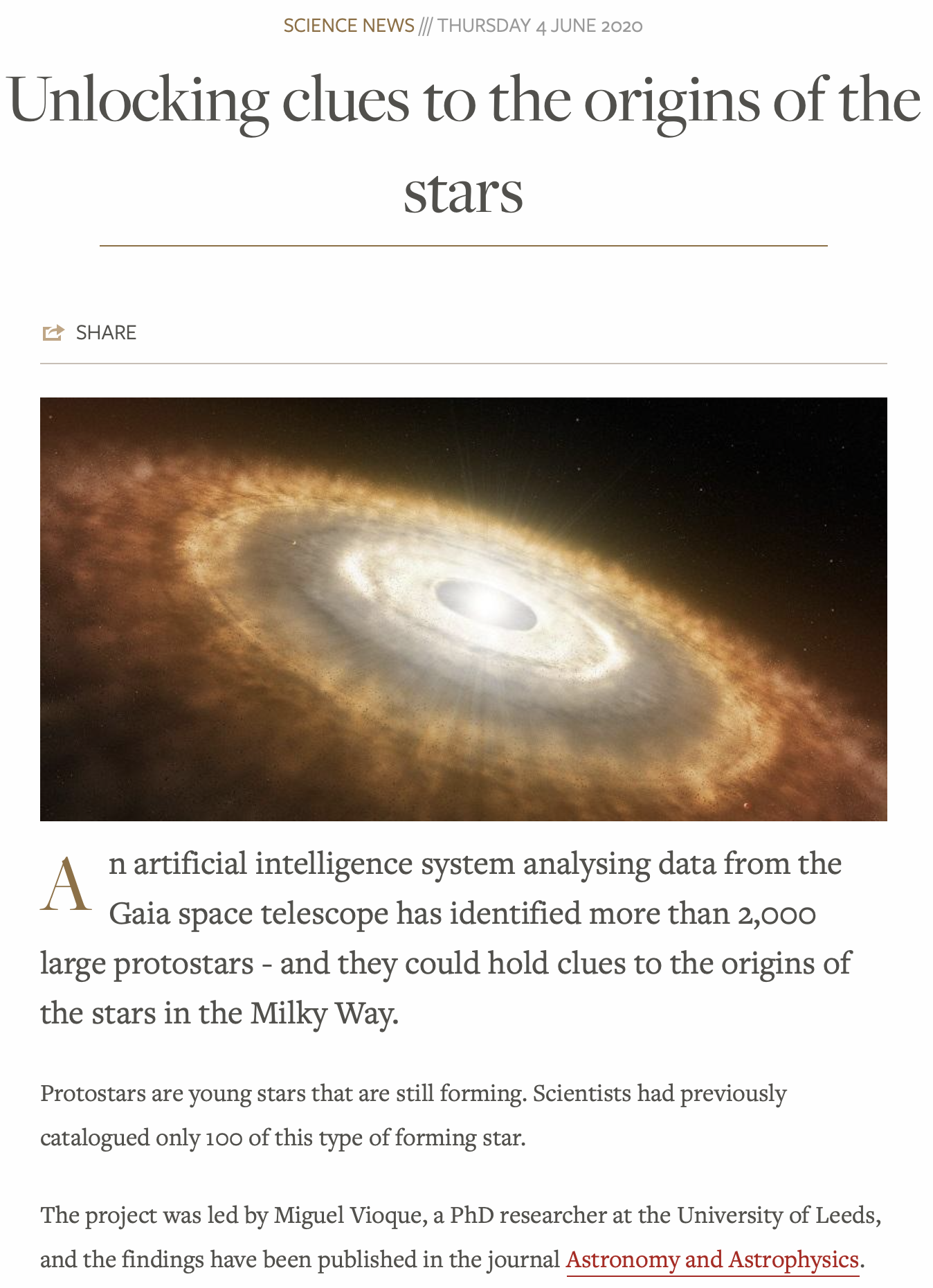
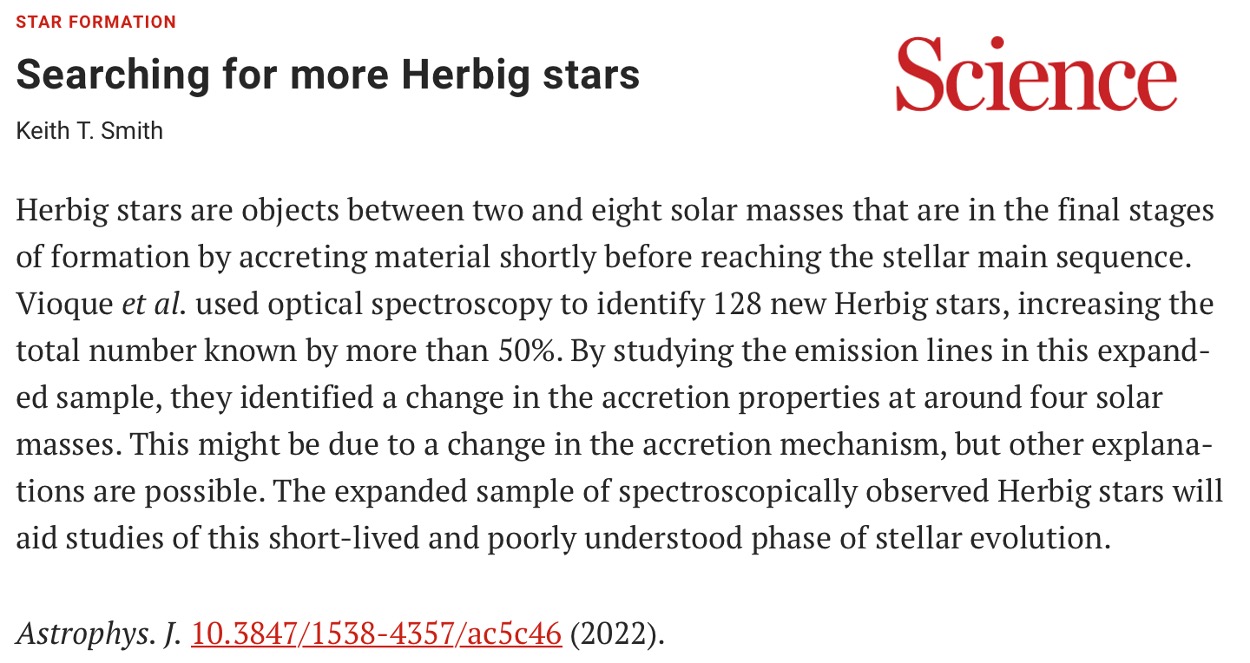
Recent highlights
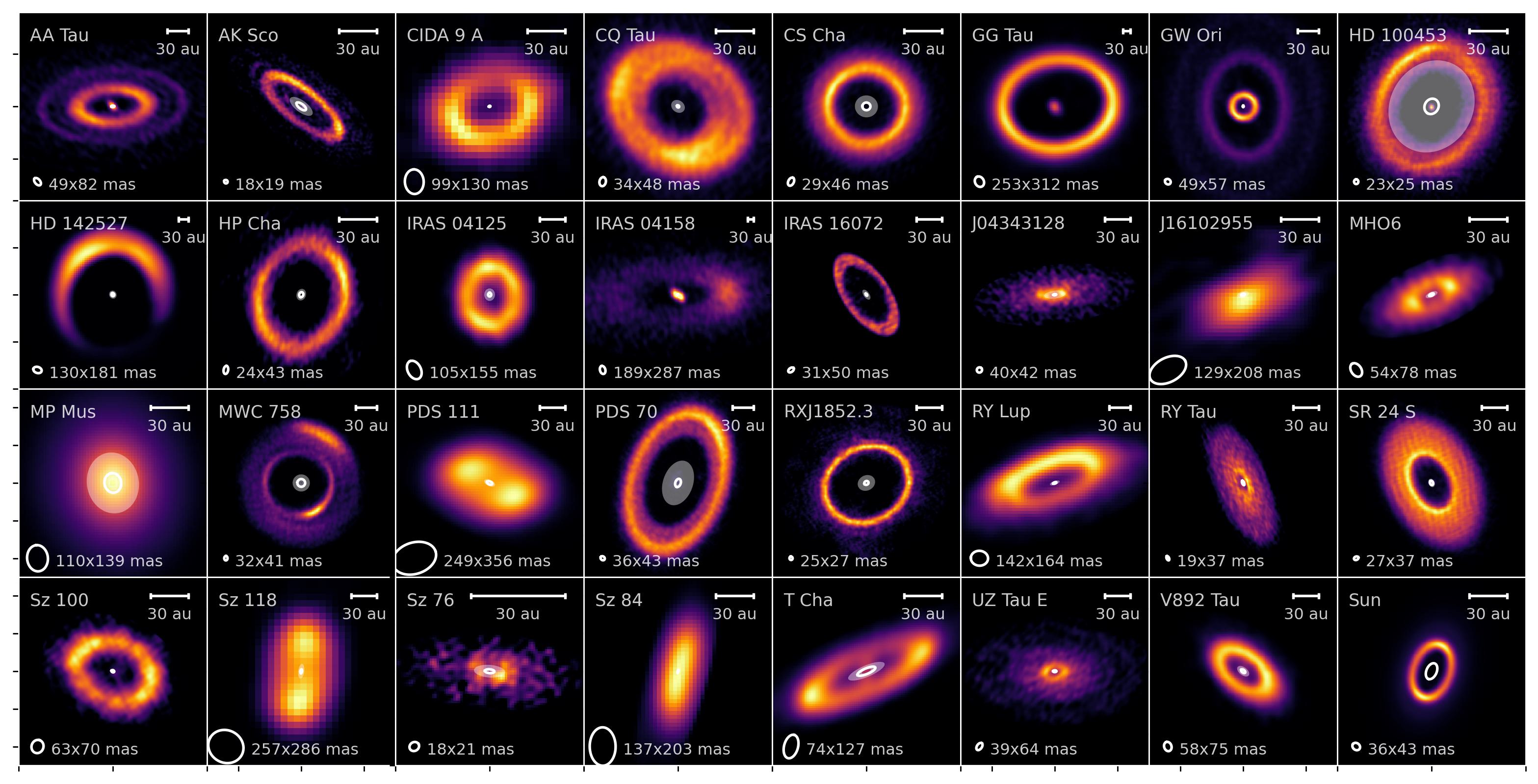
In Vioque et al. (accepted for publication in Astronomy & Astrophysics), we present a Gaia astrometric analysis aimed at detecting stellar and sub-stellar companions within the inner dust cavities of protoplanetary disks (commonly referred to as 'transition disks').
Cyan shaded areas indicate companion location. We compare the companion detection rates in these systems with those in other populations to investigate the origin of large inner dust cavities.
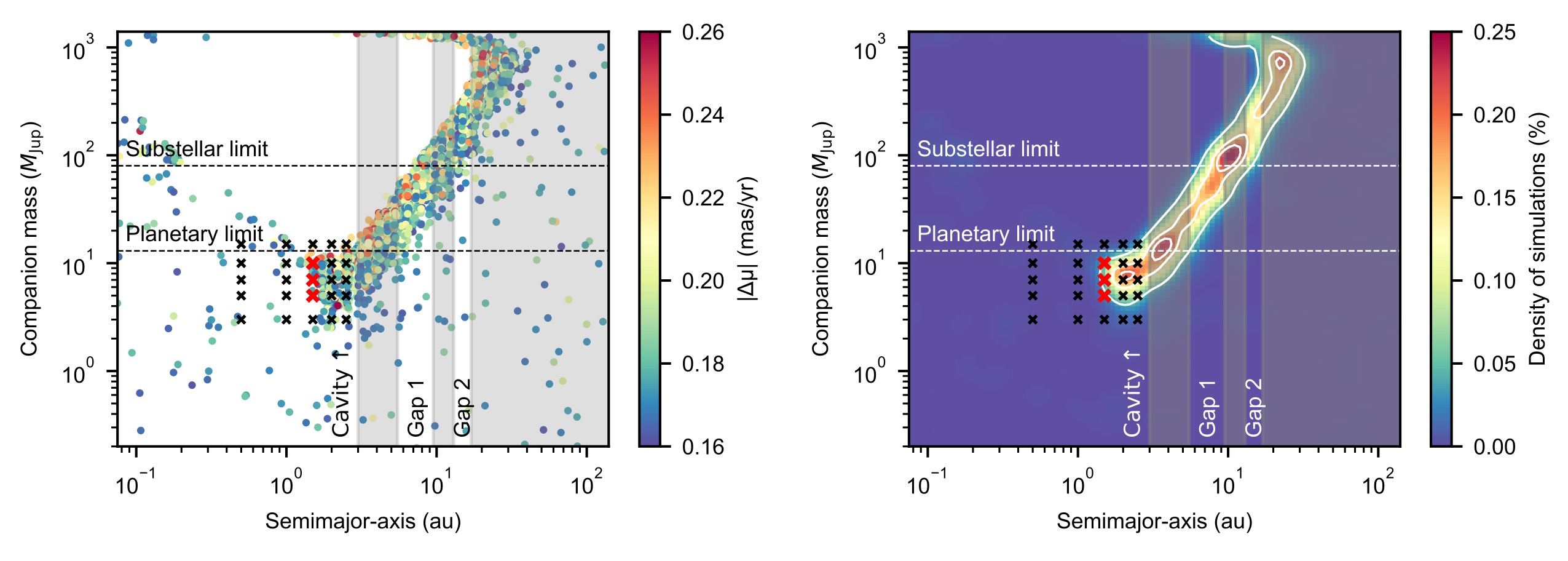
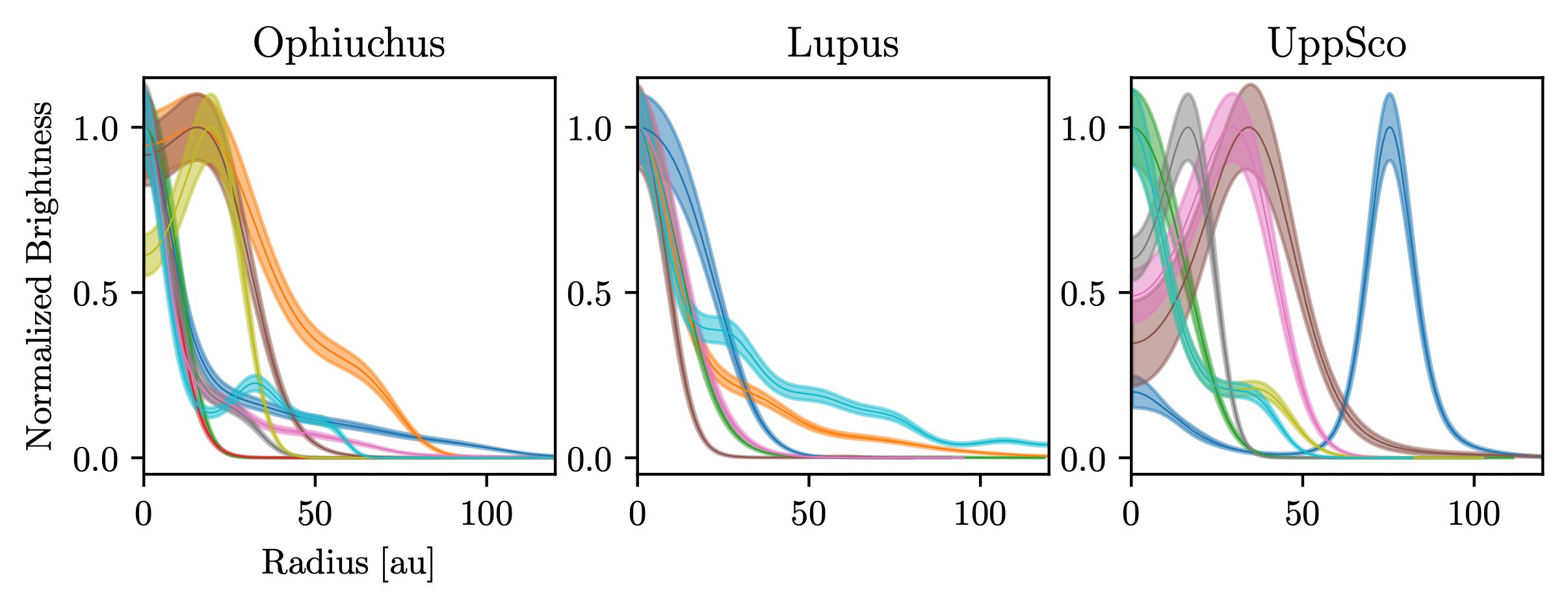
In
Vioque et al. (2025, The Astrophysical Journal), part of the
12-paper AGE-PRO collaboration release, we analysed ALMA dust-continuum observations of 30 protoplanetary
disks across three star-forming regions using visibility fitting. We determined disk geometries and dust-disk radii, identifying substructures in half of the sample.
Our results show an increased prevalence of pressure dust traps and large inner cavities
(transition disks) at later evolutionary stages. Notably, 80% of resolved Class I disks in Ophiuchus exhibit dust substructures,
demonstrating their early emergence. Additionally, we detected a spiral in IRS 63,
indicative of gravitational instability in this massive disk.
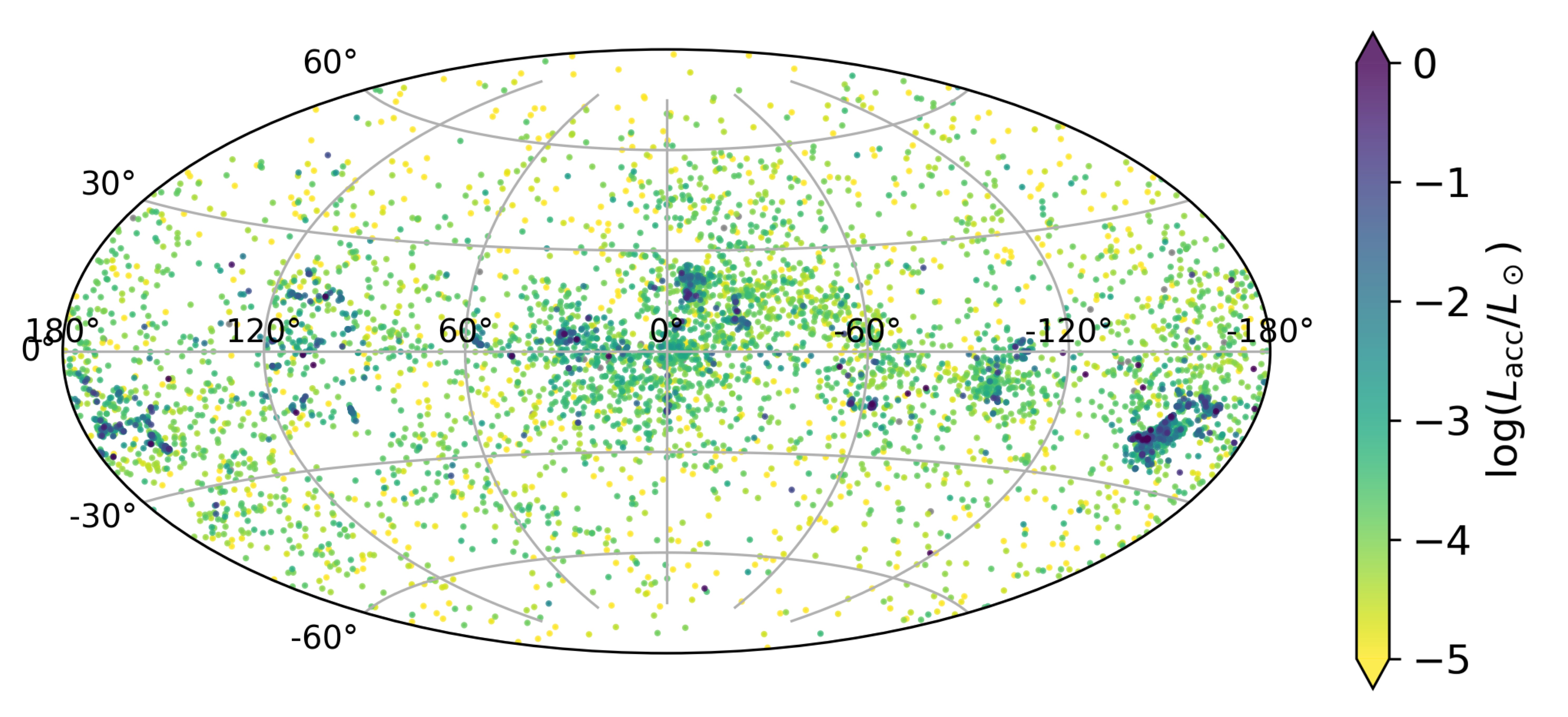
In
Delfini, Vioque, et al. (2025, Astronomy & Astrophysics), we performed the first all-sky homogeneous analysis of young stellar object (YSO) accretion within 500 pc
using Gaia DR3 XP spectra, identifying many previously undetected low-accretion sources. We derived an accretion timescale of 2.7±0.4 Myr, finding that the fraction of accreting YSOs
declines from 70% at 2 Myr to 2.8% at 10 Myr.
Publications
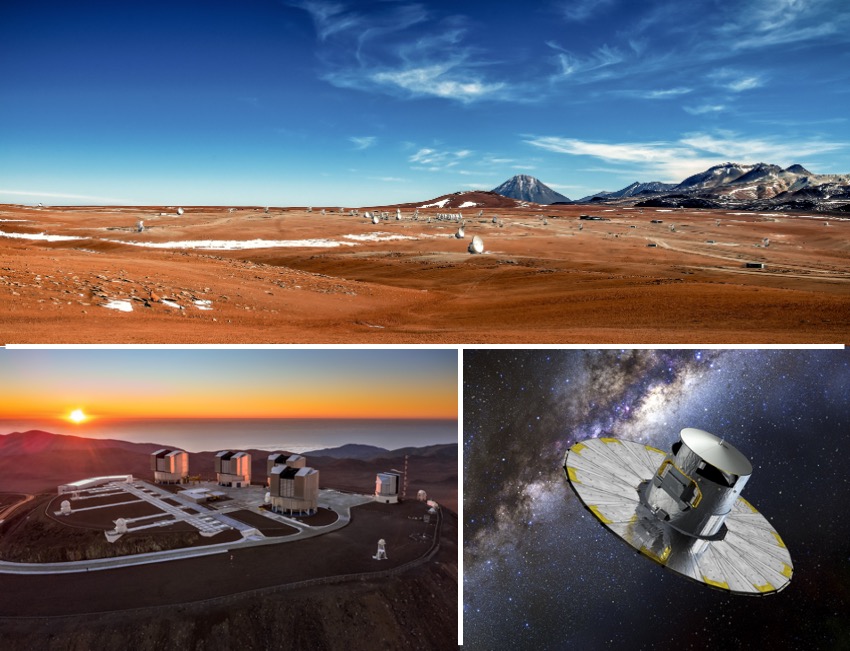
Please find the link to my publication record in ADS here.
Refereed publications
- Vioque M., Booth R. A., Ragusa E., Ribas Á., Kurtovic N. T., Rosotti G. P., Penoyre Z., Facchini S., Garufi A., Manara C. F., Huélamo N., Winter A., Pérez S., Benisty M., Mendigutía I., Cuello N., Penzlin A. B. T., Castro-Ginard A., Teague R., Astrometric view of companions in the inner dust cavities of protoplanetary disks, accepted for publication in A&A
- Zallio L., Rosotti G. P., Vioque M., Miotello A., Andrews S. M., Manara C. F., Carpenter J. M., Empey A., Kurtovic N. T., Law C. J., Longarini C., Paneque-Carreño T., Teague R., Villenave M., Yen H-W, Zagaria F., The 12CO Gas Structures of Protoplanetary Disks in the Upper Scorpius Region, accepted for publication in A&A
- Miley J. M., Kennedy G. M., Ribas Á., Macias E., Carpenter J., Vioque M., Luhman K., Haworth T., Weber P., Perez S., Zurlo A., Resolving the large exoKuiper belt of the HD 126062 debris disc and extended gas emission in its vicinity, 2025, A&A, 703, A235
- Alaguero A., Ménard F., Cuello N., Ribas Á., Viscardi E., Macías E., Vioque M., Miley J., Probing dust and grain growth in the optically thick circumbinary ring of V892 Tau, 2025, A&A, 703, A210
- Pinilla P., Sierra A., Kurtovic N. T., Anania R., Andrews S., Carpenter J., Guerra-Alvarado O., Long F., Marino S., Vioque M., Zhang K., Observational Constraints on Evolution of Dust Disc Properties in Upper Scorpius, 2025, MNRAS, 543, 2723
- Krijt S., Banzatti A., Zhang K., Pinilla P., Kaeufer T., Bergin E. A., Salyk C., Pontoppidan K., Blake G. A., Long F., Huang J., José Colmenares M., Williams J., Houge A., Narang M., Vioque M., Lambrechts M., Cleeves L. I., Öberg K., JDISCS collaboration, Cosmic cascades: How disk substructure regulates the flow of water to inner planetary systems, 2025, ApJL, 990, L72
- Ribas Á., Vioque M., Zagaria F., Longarini C., Macías E., Clarke C. J., Pérez S., Carpenter J., Cuello N., de Gregorio-Monsalvo I., A young gas giant and hidden substructures in a protoplanetary disk, 2025, Nature Astronomy, 9, 1176
- Miley J., Pérez L. M., Agurto-Gangas C., Sierra A., Trapman L., Vioque M., Kurtovic N. T., Pinilla P., Pascucci I., Zhang K., Anania R., Carpenter J., Cieza L. A., Deng D., González-Ruilova C., Rosotti G. P., Ruíz-Rodriguez D. A., TorresVillanueva E., The ALMA Survey of Gas Evolution of PROtoplanetary Disks (AGE-PRO) XII: Extreme mm variability in an Upper Scorpius Class II disc, 2025, ApJ, 989, 11
- Trapman L., Vioque M., Kurtovic N. T., Zhang K., Rosotti G. P., Pinilla P., Carpenter J., Cieza L. A., Pascucci I., Anania R., Agurto-Gangas C., Deng D., Miley J., Pérez L. M., Sierra A., Tabone B., Ruíz-Rodriguez D. A., González-Ruilova C., TorresVillanueva E., The ALMA Survey of Gas Evolution of PROtoplanetary Disks (AGE-PRO): XI. Beam-corrected gas disk sizes from fitting 12CO moment zero maps, 2025, ApJ, 989, 10
- Vioque M., Kurtovic N. T., Trapman L., Sierra A., Pérez L. M., Zhang K., Curone P., Rosotti G. P., Carpenter J., Tabone B., Pinilla P., Deng D., Pascucci I., Miley J., Agurto-Gangas C., Cieza L. A., Anania R., Ruíz-Rodriguez D. A., González-Ruilova C., TorresVillanueva E., Kuznetsova A., The ALMA Survey of Gas Evolution of PROtoplanetary Disks (AGE-PRO): X. Dust substructures, disk geometries, and dust-disk radii, 2025, ApJ, 989, 9
- Anania R., Rosotti, G. P., Gárate M., Pinilla P., Vioque M., Trapman L., Carpenter J., Zhang K., Pascucci I., Cieza L. A., Sierra A., Kurtovic N. T., Miley J., Pérez L. M., Tabone B., Hogerheijde M. R., Deng D., Agurto-Gangas C., Ruíz-Rodriguez D. A., González-Ruilova C., TorresVillanueva E., The ALMA Survey of Gas Evolution of PROtoplanetary Disks (AGE-PRO): VIII. The impact of external photoevaporation on disk masses and radii in Upper Sco, 2025, ApJ, 989, 8
- Tabone B. Rosotti G. P., Trapman L., Pinilla P., Pascucci I., Somigliana A., Alexander R., Vioque M., Anania R., Kuznetsova A., Zhang K., Pérez L. M., Cieza L. A., Carpenter J., Deng D., Agurto-Gangas C., Ruíz-Rodriguez D. A., Sierra A., Kurtovic N. T., Miley J., González-Ruilova C., TorresVillanueva E., Hogerheijde M. R., Schwarz K., Toci C., Testi L., Lodato G., The ALMA Survey of Gas Evolution of PROtoplanetary Disks (AGE-PRO): VII. Testing accretion mechanisms from disk population synthesis, 2025, ApJ, 989, 7
- Kurtovic N. T., Gárate M., Pinilla P., Zhang K., Rosotti G. P., Anania R., Pascucci I., Tabone B., Trapman L., Carpenter J., Cieza L. A., Deng D., Vioque M., Pérez L. M., Agurto-Gangas C., Ruíz-Rodriguez D. A., Sierra A., Miley J., González-Ruilova C., Torres-Villanueva E., The ALMA Survey of Gas Evolution of PROtoplanetary Disks (AGE-PRO): VI. Comparison of Dust Evolution Models to AGE-PRO Observations, 2025, ApJ, 989, 6
- Trapman L., Zhang K., Rosotti G. P., Pinilla P., Tabone B., Pascucci I., Agurto-Gangas C., Anania R., Carpenter J., Cieza L. A., Deng D., González-Ruilova C., Hogerheijde M. R., Kurtovic N. T., Kuznetsova A., Miley J., Pérez L. M., Ruíz-Rodriguez D. A., Schwarz K., Sierra A., TorresVillanueva E., Vioque M., The ALMA Survey of Gas Evolution of PROtoplanetary Disks (AGE-PRO): V. Protoplanetary gas disk masses, 2025, ApJ, 989, 5
- Agurto-Gangas C., Pérez L. M., Sierra A., Miley J., Zhang K., Pascucci I., Pinilla P., Deng D., Carpenter J., Trapman L., Vioque M., Rosotti G. P., Kurtovic N. T., Cieza L. A., Schwarz K., Hogerheijde M. R., Anania R., Tabone B., TorresVillanueva E., Ruíz-Rodriguez D. A., González-Ruilova C., The ALMA Survey of Gas Evolution of PROtoplanetary Disks (AGE-PRO): IV. Dust and Gas Disk Properties in the Upper Scorpius Star-forming Region, 2025, ApJ, 989, 4
- Deng D., Vioque M., Pascucci I., Pérez L. M., Zhang K., Kurtovic N. T., Trapman L., TorresVillanueva E., Agurto-Gangas C., Carpenter J., Pinilla P., Gorti U., Tabone B., Sierra A., Rosotti G. P., Cieza L. A., Anania R., González-Ruilova C., Hogerheijde M. R., Miley J., Ruíz-Rodriguez D. A., Ruaud M., Schwarz K., The ALMA Survey of Gas Evolution of PROtoplanetary Disks (AGE-PRO): III. Dust and Gas Disk Properties in the Lupus Star-forming Region, 2025, ApJ, 989, 3
- Ruíz-Rodriguez D. A., González-Ruilova C., Cieza L. A., Zhang K., Trapman L., Pinilla P., Pascucci I., Pérez L. M., Deng D., Agurto-Gangas C., Carpenter J., Tabone B., Rosotti G. P., Sierra A., Anania R., Miley J., Schwarz K., Vioque M., Kurtovic N. T., The ALMA Survey of Gas Evolution of PROtoplanetary Disks (AGE-PRO): II. Gas and Dust in the Ophiuchus Star-forming Region, 2025, ApJ, 989, 2
- Zhang K., Pérez L. M., Pascucci I., Pinilla P., Cieza L. A., Carpenter J., Trapman L., Deng D., Agurto-Gangas C., Sierra A., Kurtovic N. T., Ruíz-Rodriguez D. A., Vioque M., Miley J., Tabone B., González-Ruilova C., Anania R., Rosotti G. P., TorresVillanueva E., Hogerheijde M. R., Schwarz K., Kuznetsova A., The ALMA Survey of Gas Evolution of PROtoplanetary Disks (AGE-PRO): I. Program Overview and Summary of First Results, 2025, ApJ, 989, 1
- Arulanantham N., Salyk C., Pontoppidan K., Banzatti A., Zhang K., Öberg K., Long F., Carr J., Najita J., Pascucci I., Colmenares M. J., Xie C., Huang J., Green J., Andrews S. M., Blake G. A., Bergin E. A., Pinilla P., Vioque M., Dahl E., Raul E., Krijt S., JDISCS Collaboration, The JDISC Survey: Linking the physics and chemistry of inner & outer protoplanetary disk zones, 2025, AJ, 170, 67
- Delfini L., Vioque M., Ribas Á., Hodgkin S., Star formation and accretion rates within 500 pc as traced by Gaia DR3 XP spectra, 2025, A&A, 699, A145
- Ragusa E., Lodato G., Cuello N., Vioque M., Manara C. F., Toci C., The likelihood of not detecting cavity-carving companions in transition discs – A statistical approach, 2025, A&A, 698, A102
- Radley I. C., Oudmaijer R. D., Vioque M., Dodd J. M., A Photometric Comparison of B and Be stars using Gaia DR3, 2025, MNRAS, 539, 1964
- Anania R., Winter A., Rosotti G., Vioque M., Zari E., Pantaleoni González M., Testi L., A novel method to estimate the FUV flux and a catalogue for star-hosting discs in nearby star-forming regions, 2025, A&A, 695, A74
- Stapper L. M., Hogerheijde M. R., van Dishoeck E. F., Vioque M., Williams J. P., Ginski C., Intermediate mass T Tauri disk masses and a comparison to their Herbig disk descendants, 2025, A&A, 693, A286
- Long F., Pascucci I., Houge A., Banzatti A., Pontoppidan K. M., Najita J., Krijt S., Xie C., Williams J., Herczeg G. J., Andrews S. M., Bergin E., Blake G. A., Colmenares M. J., Harsono D., Muñoz-Romero C. E., Li R., Lu C. X., Pinilla P., Wilner D. J., Vioque M., Zhang K., JDISCS collaboration, The First JWST View of a 40-Myr-old Protoplanetary Disk: the late-stage carbon-rich phase, 2025, ApJL, 978, L30
- Sierra A., Pérez L. M., Agurto-Gangas C., Miley J., Zhang K., Pinilla P., Pascucci I., Trapman L., Kurtovic N., Vioque M., Deng D., Anania R., Carpenter J., Cieza L. A., González-Ruilova C., Hogerheijde M., Kuznetsova A., Rosotti G. P., Ruiz-Rodriguez D. A., Schwarz K., Tabone B., TorresVillanueva E. E., Hints of planet formation signatures in a large-cavity disk
studied in the AGE-PRO ALMA Large Program, 2024, ApJ, 974, 102
- Messias H., Guerrero A., Nagar N., Regueiro J., Impellizzeri V., Orellana G., Vioque M., HI content at cosmic noon - a millimeter-wavelength perspective, 2024, MNRAS, 533, 3937
- Alaguero A., Cuello N., Ménard F., Ceppi S., Ribas Á., Nealon R., Vioque M., Izquierdo A., Miley J., Macías E., Price D. J., V892 Tau: A tidally perturbed circumbinary disc in a triple stellar system, 2024, A&A, 687, A311
- Mendigutía I., Lillo-Box J., Vioque M., Maldonado J., Montesinos B., Huélamo N., Wang J., Gas and not dust: migration of TESS/Gaia hot Jupiters may be halted by magnetospheres in protoplanetary disks, 2024, A&A Letters, 686, L1
- Lillo-Box J., Morales-Calderón M., Barrado D., Balsalobre-Ruza O., Castro-González A., Mendigutía I., Huélamo N., Montesinos B., Vioque M., The AstraLux-TESS high-spatial resolution imaging survey. Search for stellar companions of 215 planet candidates from TESS, 2024, A&A, 686, A232
- Miley J. M., Carpenter J., Booth R., Jennings J., Haworth T. J., Vioque M., Andrews S., Wilner D., Benisty M., Huang J., Perez L., Guzman V., Ricci L., Isella A., High-resolution ALMA observations of compact discs in the wide-binary system Sz 65 and Sz 66, 2024, A&A, 682, A55
- Dodd J. M., Oudmaijer R. D., Radley I. C., Vioque M., Frost A. J., Gaia uncovers difference in B and Be star binarity at small scales: evidence for mass transfer causing the Be phenomenon, 2024, MNRAS, 527, 3076
- Shoko J., Trager S. C., Dalton G. B., and et al. (with Vioque M.), The wide-field, multiplexed, spectroscopic facility WEAVE: Survey design, overview, and simulated implementation, 2024, MNRAS, 530, 2688
- Vioque M., Cavieres M., Pantaleoni González M., Ribas Á., Oudmaijer R. D., Mendigutía I., Kilian L., Cánovas H., Kuhn M., Clustering properties of intermediate and high-mass Young Stellar Objects, 2023, AJ, 166, 183
- Grant S. L., Stapper L. M., Hogerheijde M. R., van Dishoeck E. F., Brittain S., Vioque M., The Mdot–Mdisk relationship for Herbig Ae/Be stars: a lifetime problem for disks with low masses?, 2023, AJ, 166, 147
- Pascucci I., Skinner B. N., Deng D., Ruaud M., Gorti U., Schwarz K. R., Chapillon E., Vioque M., Miley J., Large Myr-old Disks Are Not Severely Depleted of Gas-phase CO or Carbon, 2023, ApJ, 953, 183
- France K., Arulanantham N., Maloney E., Cauley P. W., Ábrahám P., Alcalá J. M., Campbell-White J., Fiorellino E., Herczeg G. J., Nisini B., Vioque M., The Radial Distribution and Excitation of H2 around Young Stars in the HST-ULLYSES Survey, 2023, AJ, 166, 67
- Arulanantham N., Gronke M., Fiorellino E., Gameiro J. F., Frasca A., Green J., Chang S. J.,
Claes R. A. B., Espaillat C., France K., Herczeg G. J., Manara C. F., Venuti L., Ábrahám P.,
Alexander R., Bouvier J., Campbell-White J., Eislöffel J., Fischer W. J., Kóspál A., Vioque M., Lyα Scattering Models Trace Accretion and Outflow Kinematics in T Tauri Systems, 2023, ApJ, 944, 185
- Guzmán-Díaz J., Montesinos B., Mendigutía I., Kama M., Meeus G., Vioque M., Oudmaijer R.
D., Villaver E., Relation between metallicities and spectral energy distributions of Herbig Ae/Be stars. A potential link with planet formation, 2023, A&A, 671, A140
- Iglesias D. P., Panić O., van den Ancker M., Petr-Gotzens M., Siess L., Vioque M., Pascucci
I., Oudmaijer R. D., Miley J., X-shooter survey of young intermediate-mass stars - I. Stellar characterization and disc evolution, 2023, MNRAS, 519, 3958
- Oudmaijer R. D., Jones E. R. M., Vioque M., A census of post-AGB stars in Gaia DR3: Evidence for a substantial population of Galactic post-RGB stars, 2022, MNRAS Letters, 516, L61-L65
- Mendigutía I., Solano E., Vioque M., Balaguer-Nuñez L., Ribas Á., Huélamo N., Rodrigo C., Gaia EDR3 comparative study of protoplanetary disk fractions in young stellar clusters, 2022, A&A, 664, A66
- Vioque M., Oudmaijer R. D., Wichittanakom C., Mendigutía I., Baines D., Panić O., Iglesias D., Miley J., Pérez-Martínez R., Identification and spectroscopic characterization of 128 new Herbig stars, 2022, ApJ, 930, 39
- Koumpia E., de Wit W.-J., Oudmaijer R. D., Frost A. J., Lumsden S., Caratti o Garatti A., Goodwin S. P., Stecklum B., Mendigutía I., Ilee J. D., Vioque M., The first interferometric survey in the K-band of massive YSOs. Hot dust, ionised gas, and binarity at au scales, 2021, A&A, 654, A109
- Marcos-Arenal P., Mendigutía I., Koumpia E., Oudmaijer R. D., Vioque M., Guzmán-Díaz J., Wichittanakom C., de Wit W. J., Montesinos B., Ilee J. D., K-band GRAVITY/VLTI interferometry of "extreme" Herbig Be stars. The size-luminosity relation revisited, 2021, A&A, 652, A68
- van den Ancker M. E., Gentile Fusillo N. P., Haworth T. J., Manara C. F., Miles-Páez P. A., Oudmaijer R. D., Panić O., Petit dit de la Roche D. J. M., Petr-Gotzens M. G., Vioque M., First detection of a disk free of volatile elements around a young A-type star: A possible sign of collisions between rocky planets, 2021, A&A Letters, 651, L11
- Guzmán-Díaz J., Mendigutía I., Montesinos B., Oudmaijer R. D., Vioque M., Rodrigo C., Solano E., Meeus G., Marcos-Arenal P., Homogeneous study of Herbig Ae/Be stars from spectral energy distributions and Gaia EDR3, 2021, A&A, 650, A182
- Panić O., Haworth T. J., Petr-Gotzens M. G., Miley J., van den Ancker M., Vioque M., Siess L., Parker R., Clarke C. J., Kamp I., Kennedy G., Oudmaijer R. D., Pascucci I., Richards A. M. S., Ratzka T., Qi C., Planet formation in intermediate-separation binary systems, 2021, MNRAS, 501, 4317
- Vioque M., Oudmaijer R. D., Schreiner M., Mendigutía I., Baines D., Mowlavi N., Pérez-Martínez R., Catalogue of new Herbig Ae/Be and classical Be stars: A machine learning approach to Gaia DR2, 2020, A&A, 638, A21
- Wichittanakom C., Oudmaijer R. D., Fairlamb J. R., Mendigutía I., Vioque M., Ababakr K. M., The accretion rates and mechanisms of Herbig Ae/Be stars, 2020, MNRAS, 493, 234
- Vioque M., Oudmaijer R. D., Baines D., Mendigutía I., Pérez-Martínez R., Gaia DR2 study of Herbig Ae/Be stars, 2018, A&A, 620, A128
Non-refereed publications
- Mendigutía I., Marcos-Arenal P., Koumpia E., Oudmaijer R. D., Vioque M., Guzmán-Díaz J., Wichittanakom C., de Wit W. J., Montesinos B., Ilee J. D., What determines the inner sizes of protoplanetary disks?, 2023, Highlights of Spanish Astrophysics XI, Proceedings of the XV Scientific Meeting of the Spanish Astronomical Society held on September 4--9, 2022, in La Laguna, Spain
- Mendigutía I., Solano E., Vioque M., Balaguer-Nuñez L., Ribas Á., Huélamo N., Rodrigo C., Gaia-based comparative study of protoplanetary disk frequencies in young stellar clusters, 2023, Highlights of Spanish Astrophysics XI, Proceedings of the XV Scientific Meeting of the Spanish Astronomical Society held on September 4--9, 2022, in La Laguna, Spain
- Vioque M., Accretion on populations of intermediate and high-mass YSOs, 2022, Accretion/Ejection Processes in Star Formation: In Theory and in Practice (accrete2022), held 30 November – 2 December, 2022 at ESO Santiago, Chile, id.3
- Mendigutía I., Solano E., Vioque M., Ribas A., Gaia EDR3 comparison of disk fractions from different spatial scales around young stellar clusters, 2021, Star Clusters: the Gaia Revolution. Online workshop, organised by the Institute of Cosmos Sciences (ICCUB-IEEC), id.6
- Vioque M., Wichittanakom C., Oudmaijer R. D., Schreiner M., Mendigutía I., Baines D., Mowlavi N., Pérez-Martínez R., Cataloguing new high-mass Pre-Main Sequence and Classical Be stars using Machine Learning and Gaia, 2020, Contributions to the XIV.0 Scientific Meeting (virtual) of the Spanish Astronomical Society, id. 192
- Vioque M., Oudmaijer R. D., Baines D., Pérez-Martínez R., New catalogue of intermediate mass Pre-Main Sequence objects in Gaia DR2 using Machine Learning, 2019, 53rd ESLAB Symposium: The Gaia Universe, id. 52
- Vioque M., Oudmaijer R. D., Baines D., Mendigutía I., Pérez-Martínez R., Gaia study on the formation of intermediate mass stars, 2019, Highlights on Spanish Astrophysics X, Proceedings of the XIII Scientific Meeting of the Spanish Astronomical Society, p. 437-437
- Vioque M., Oudmaijer R. D., Baines D., Herbig Ae/Be stars with TGAS parallaxes in the HR diagram, 2018, Astrometry and Astrophysics in the Gaia sky, Proceedings of the International Astronomical Union, Volume 330, pp. 277-278
- Vioque M., Oudmaijer R. D., Baines D., HR diagram of Herbig Ae/Be stars and their infrared excesses, 2017, Memorie della Societa Astronomica Italiana, v.88, p.824
Miscellaneous
IDEEA association
I am a member of the IDEEA association – Inclusion, Diversity, and Equity in European Astronomy. IDEEA is an open forum for discussion and activities on all topics related to ethics and inclusion in astronomy (and also outside astronomy). I encourage interested colleagues to contact me or another IDEEA member to participate in the association. Anyone is welcome to join and more information can be found here.
Historical overview of star formation and Herbig Ae/Be stars
I wrote this (very) brief overview of the history of star formation and Herbig Ae/Be stars for the introduction of my PhD thesis. Those interested in the history of science might find it worth-reading. I compiled literature information and nothing in it is original research.
Conference talks and seminars
If we met at some point, it might have been in one of the below meetings!
- 2025 – Multiplicity in Young Stars (Copenhagen, Denmark): On the use of Gaia astrometry to indentify companions in Young Stars
- 2024 – Deep Learning IndabaX: Ethical AI Horizons, Navigating the Impact and Future of AI Across Diverse Sectors (Kampala, Uganda): Talk and workshop – Mapping Billions of Stars with Gaia and Other Space Telescopes
- 2024 – Spanish Astronomical Society Meeting (Granada, Spain): AGE-PRO: The ALMA Survey of Gas Evolution in PROtoplanetary disks
- 2024 – First meeting: The birth of solar systems (PLANETS) COST Action (Torun, Poland): AGE-PRO: The ALMA Survey of Gas Evolution in PROtoplanetary disks
- 2024 – European Astronomical Society Annual Meeting (Padova, Italy): Clustering properties of intermediate and high-mass Young Stellar Objects
- 2024 – European Astronomical Society Annual Meeting (Padova, Italy): AGE-PRO: The ALMA Survey of Gas Evolution in PROtoplanetary disks
- 2024 – Star Formation across cosmic scales: Machine Learning insights and applications (Budapest, Hungary): Clustering properties of intermediate and high-mass Young Stellar Objects
- 2024 – Seminar (Harvard and Smithsonian Center for Astrophysics, Cambridge, US): On the Galactic population of Herbig stars
- 2024 – Invited talk, Stellar-MADE ERC Winter Meeting (Grenoble, France): Herbig Ae/Be stars, brainstorm and discussion
- 2023 – Seminar (Côte d'Azur Observatory, Nice, France)
- 2023 – Seminar (University of Milan, Milan, Italy)
- 2023 – Seminar (University of Valparaíso, Valparaíso, Chile): On the distribution of massive forming stars in the Galaxy
- 2023 – Seminar (Arcetri Astrophysical Observatory, Florence, Italy): Clustering properties of intermediate and high-mass Young Stellar Objects
- 2023 – Seminar (University of Bologna, Bologna, Italy): Clustering properties of intermediate and high-mass Young Stellar Objects
- 2023 – Gaia XPloration: Discovery and measurement with low-resolution spectroscopy (University of Cambridge, Cambridge, United Kingdom): Clustering properties and Galactic distribution of intermediate and high-mass YSOs using Gaia DR3 and unsupervised machine learning
- 2022 – Accretion/Ejection Processes in Star Formation: In Theory and in Practice (ESO, Santiago, Chile): Accretion on populations of intermediate and high-mass YSOs
- 2022 – Seminar (Department of Astronomy, University of Geneva): On the distribution of massive forming stars in the Galaxy
- 2022 – Seminar (Spanish Group of Massive Stars, online): The dearth of O-stars close to the ZAMS. Link with the measured accretion rates in high-mass YSOs
- 2022 – XV Reunión Científica de la Sociedad Española de Astronomía (La Laguna, Spain): A new perspective on the intermediate- to high-mass star formation
- 2022 – European Astronomical Society Annual Meeting (Valencia, Spain): Revisiting the intermediate- to high-mass star formation with machine learning
- 2022 – From Stars to Galaxies II. Connecting our Understanding of Star and Galaxy Formation (Chalmers University, Gothenburg, Sweden): Revisiting the intermediate- to high-mass star formation
- 2022 – Seminar (Instituto de Astrofísica de Andalucía, Granada, Spain): Revisiting the intermediate- to high-mass star formation
- 2022 – Joint Observatories Kavli Science Forum (ESO, Santiago, Chile): Revisiting the intermediate- to high-mass star formation
- 2021 – Machine Learning in Astronomy, from classical to physics-informed (virtual workshop): Member of the discussion session and of the round table
- 2021 – Seminar (Núcleo Milenio for Planet Formation, Valparaíso, Chile): Finding new forming high-mass stars
- 2021 – Invited talk, Workshop en ciencia de datos (Universidad de Valparaíso, Valparaíso, Chile): Machine learning en astronomía y resolución de problemas con muchas incógnitas
- 2020 – Seminar (University of Leeds, Leeds, UK): Catalogue of new high-mass Pre-Main Sequence and Classical Be stars. A Machine Learning approach to Gaia data
- 2020 – Seminar (Universidad de Chile, Santiago, Chile): Catalogue of new high-mass Pre-Main Sequence and Classical Be stars. A Machine Learning approach to Gaia data
- 2020 – Seminar (ESO, Santiago, Chile): Catalogue of new high-mass Pre-Main Sequence and Classical Be stars. A Machine Learning approach to Gaia DR2
- 2019 – Seminar (Sternberg Astronomical Institute, Moscow, Russia): Machine Learning techniques in Astronomy
- 2019 – The UX Ori Type Stars and Related Topics (St. Petersburg, Russia): New UX Ori type candidates detected using Gaia DR2 and Machine Learning
- 2019 – Seminar (ESAC, Madrid, Spain): New Herbig Ae/Be and Classical Be candidates using Gaia and Machine Learning
- 2019 – Workshop: Artificial Intelligence in Astronomy (ESO, Garching, Germany): New catalogue of Pre-Main Sequence objects using AI
- 2019 – Gaia’s view of Pre-Main Sequence Evolution (Leeds, UK): New catalogue of Pre-Main Sequence objects using Gaia
- 2018 – Seminar (Centro de Astrobiología, Madrid, Spain): Machine Learning Algorithms and its applications to Astronomy
- 2018 – A Revolution in Stellar Physics with Gaia and Large Surveys (Warsaw, Poland): Gaia Study on the Formation of Intermediate Mass Stars
- 2018 – Spring Symposium: The 21st Century H-R Diagram: The Power of Precision Photometry (STScI, Baltimore, USA): Gaia Study on the Formation of Intermediate Mass Stars
- 2018 – Seminar (Centro de Astrobiología, Madrid, Spain): Gaia study of Herbig Ae/Be stars
- 2017 – Star Cluster Formation: Mapping the First Few Myrs (Madrid, Spain): Herbig Ae/Be stars with TGAS parallaxes in the HR diagram
- 2017 – Seminar (University of Leeds, Leeds, UK): Herbig Ae/Be stars with TGAS parallaxes in the HR diagram
Contact







